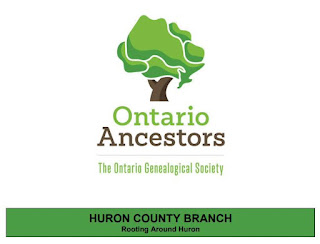#83 BOOKS AND BLOGS ABOUT HURON COUNTY
In June, I presented to the Huron County Genealogical Society in Goderich. This is the write-up about that talk published in their branch newsletter.
Books and Blogs about Huron County Carole Whelan 5 June 2024
The June Webinar speaker was Carole Whelan, author and retired history teacher from Toronto. As a certified genealogist, Carole’s quest is not merely to trace family lines but to discover and preserve the stories of her ancestors. With roots dating back to the 1850s and 1860s in Huron County, Ontario, Carole’s ancestry intertwines two pioneering families—the Netterfields from Ireland and the Homuths from Prussia.
The story begins with the Netterfield family, originally from Ballyconnell, County Cavan, Ireland. In 1847, during the height of the Great Famine, Thomas and Bessie Netterfield, along with their five children, emigrated to Canada aboard the Lord Ashburton. Their 47-day Atlantic crossing was marred by sickness and death, with 107 of the 489 passengers perishing. The Netterfields, however, survived and initially settled in Leeds County, Ontario. In 1863, they moved to Turnberry Township, Huron County, marking the beginning of the family’s settlement there.
Similarly, the Homuth family, led by Charles and Hannah, emigrated from Breitenstein, Prussia, in 1858. They embarked on the Donau from Hamburg and arrived in New York before moving to Canada. Initially settling in Waterloo County, they eventually relocated to Turnberry Township in 1862. The two families were united in 1877 with the marriage of August Homuth and Adelaide Netterfield.
For Carole, genealogy is about more than compiling names and dates. It’s about ensuring that the stories of our ancestors are remembered and understood by future generations. This commitment to storytelling has resulted in the self-publication of two books: one about Carole’s Finnish-Canadian grandfather, who had a harrowing experience in Soviet Russia during the 1930s, and another about her grandfather Fred Homuth, whose life in rural Ontario provided a wealth of material for family history.
Carole reflects on the process of writing these books, offering valuable insights for anyone interested in preserving their family history. Writing a book is an immersive and rewarding experience but requires perseverance and a clear purpose. Carole emphasizes the importance of knowing your audience—children, grandchildren, or future generations—and focusing on the stories that will resonate with them.
To organize the narrative, Carole outlines nine steps for writing a family history, beginning with the procrastination stage, which often involves doubts and excuses. However, the key to overcoming this stage is simply to start writing. The next step is to organize the chapters and determine the overall structure. In the case of Fred Homuth’s story, Carole begins with his roots in Wingham, Ontario, his education, and his early career as a telegraph operator. From there, the story follows a more thematic approach, exploring Fred’s career as a pharmacist and optometrist, his personal interests, and his involvement in the community.
Research is ongoing throughout the writing process. As Carole wrote Fred’s story, she discovered details about him, including his work as a telegraph operator and his involvement with Rexall Drugs, one of Canada’s first pharmacy franchises. Fred was also passionate about cars, owning 11 throughout his life. He sold radios and phonographs in his Harriston store, offering customers a chance to listen to the 1921 World Series. This in-depth research adds details to the narrative and helps bring ancestors to life.
Carole recognizes the importance of images to engage readers. When people pick up a genealogy book, they often flip through it to look at the pictures, so including images with captions can help illustrate the story. In addition to photographs, Carole also includes maps, family trees, and appendices with additional information that didn’t fit into the main narrative but added valuable context.
One of the most significant aspects of Carole’s genealogical journey is the importance of preserving family stories in various formats, from books to blogs. Carole runs a genealogy blog, or “geneablog,” which allows for a more flexible and ongoing approach to storytelling. Blogging has become a way to share well-researched stories and shorter personal anecdotes, ensuring that family history is preserved in an updatable and expandable format.
Some of the stories shared on the blog relate to Carole’s Huron County ancestors, such as Theodore St. Clair McDonald, who died at Vimy Ridge, and James Albert Netterfield, who was involved in a manslaughter case in 1896. These stories and others, show a family’s resilience and strength of community and provide a portrait of life in rural Ontario.
Ultimately, Carole’s goal is to ensure that the stories of her ancestors are not lost to time. Whether through books, blogs, or photograph albums, these stories are a link between past and present, helping descendants understand the strong roots from which they come. By writing down these stories, Carole is preserving a legacy that will endure for generations. You can follow Carole Whelan through her blog at https://storiesofhomuthwhelankin.blogspot.com
Copyright © 2024 Huron County Branch



Always so informative- I look forward to all the instalments.
ReplyDeleteI’ve so enjoyed your books and this blog tremendously!
ReplyDeleteYour blog is very interesting and you make it look easy! No easy feat.
ReplyDelete